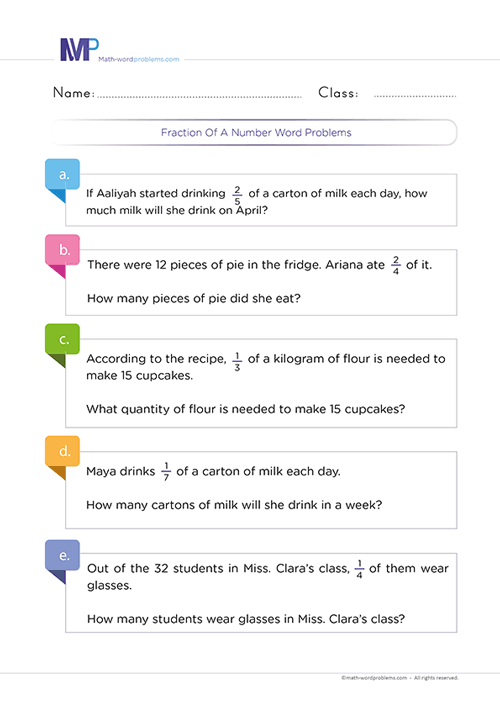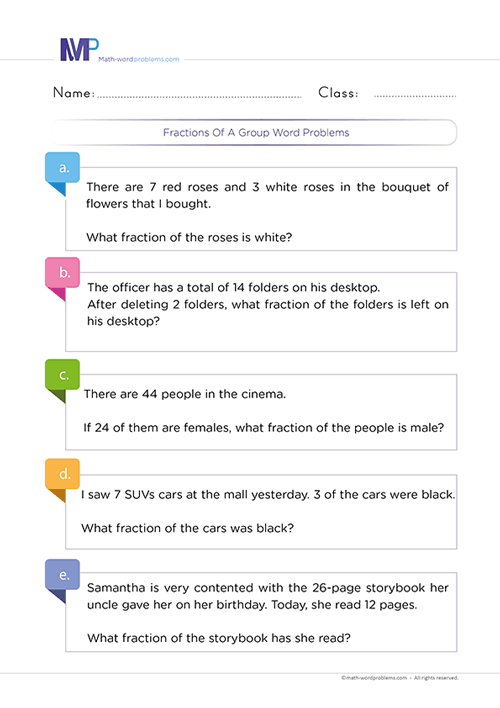 What is the best way to solve fractions of a number word problems?
What is the best way to solve fractions of a number word problems?

- INTRODUCTION
- Step 1 Identify
- Step 2 STRATEGIZE
- Step 3 SET UP
- Step 4 PROVIDE A SOLUTION
- Step 5 CHECK YOUR WORK
Get more contents on this skill...
Let's jointly discover what is the best way to solve fractions of a number word problems using our step-by-step solving guide designed for your 3rd Graders. This unique resource will provide kids with the answers they need and enhance their conceptual understanding of how to read, understand and solve all simple and challenging fractions of a number word problems.
Also, this resource will help develop learning, reasoning skills, and fractions-of-a-number problem-solving techniques in kids.
Above all, kids who struggle with understanding and solving fractions of a number word problem will find this resource very resourceful because it focuses on explicit, systematic, and procedural instructions for understanding fractions.
Steps on how to solve fractions of a number word problems
Here are simple steps on how to solve fractions of a number word problems, aimed to enhance 3rd Grader's problem-solving skills.
Given that most kids struggle to understand and solve fractions of a number, we will design short and unique steps to improve the fraction performance in learners struggling to learn fractions of a number word problem.
As we know, practice makes perfect. So, this resource will present real-world examples of fractions of a number word problems to show how these steps work.
Step 1 IDENTIFY THE PROBLEM
To identify the problem,
- Start by reading out the problem carefully to understand its description.
- Then, identify and underline related statements.
- Now, reread the problem and figure out vital information like important numbers and keywords.
Now, in fractions of a number, we look for common keywords such as "of," "times," "product of," "how many," "how much," etc.
Note: learners should understand that it would be best not to rely entirely on keywords alone because a particular keyword can have different meanings in different word problems.
In that case, you need to read the question very well to understand the situation the word problem describes. After reading, you will also find out if the problem makes sense first before determining which operation you need to use.
Step 2 STRATEGIZE AND DETERMINE THE OPERATIONS
As you move on to this step, ask yourself this pertinent question because it helps, "how will I handle this problem?"
Here, you will apply the read-to-understand rule. i.e., you have to read the word problem and try to interpret it in your own words.
Since each word problem may require a different solving format, these key points below will enable you to tackle any word problem irrespective of the format.
- First, in most cases, the keyword(s) in the word problem will help clarify the operation you need to carry out.
- But, relying on keywords alone to solve word problems has some limits, as mentioned in step 1 above.
- Hence, you must first read the word problem to understand the situation that the problem is describing.
- Reading the problem to understand will lead you to be able to identify the problem type and relative statements in the word problem, which, together with the keyword(s) in the problem, will determine the correct maths operation that you need to use
Step 3 SET UP A NUMBER SENTENCE AND AN EQUATION
- Now, after knowing which operation you will perform from step 2 above, construct short sentences to represent the information given in the word problem.
- These short sentences represent the vital information that makes it easier to solve the word problem. In order words, it is like a diagram of the word problem.
- Then, you can deduce a solvable maths equation to represent the information given in the phrases you constructed above.
Step 4 SOLVE THE PROBLEM
From step 3 above,
- Firstly, you need to convert the whole number into a fraction by dividing the whole number by 1.
- Secondly, multiply the numerators across and also multiply the denominators across. Note that when multiplying fractions, a common denominator is not needed.
- Thirdly, simplify the fraction if possible.
- Lastly, always include the unit of measurement in your final answer.
Step 5 VERIFY YOUR ANSWER
Finally, check your work to make sure that your answer is correct. For instance, since you are dealing with only numbers and not algebraic expressions, it is good to use reasonableness by estimation to see if your answer makes sense.
Therefore, if you estimate and the answer is close to what you have, your answer is correct. However, if your answer is beyond reasonable limits, you must go back to step one and start again.
Examples of how to solve fractions of a number word problems
Example One
Step 1:Read the problem and underline all the relational statements. The important numbers here are $400 and
Step 2:Now, the question is, how will you solve this problem? Which is the whole, and which is the part?
Here, you need to reread the problem and interpret it in your own words without numbers or fractions to come out with the correct operation without necessarily depending on the keyword.
The problem is trying to say that Mr. Jones took a certain fraction of his money and used it.
Now, the problem wants you to find the money he used.
Now, "which operation can I use to find the parts of a whole?"
Back to the given problem, the part is the fraction of money he used, and the whole is the amount he had.
So, from the situation that the problem is describing, from retelling the problem in your own words, and from the keyword equally found in the word problem, it shows that it is a multiplication of fractions of a number problem; hence you need to perform a multiplication problem.
Step 3: Next, construct short sentences representing the most vital information in the word problem.
Now, you need to translate the sentence that is in bold below into an accurate solvable math equation.
- Amount of money he had = $400
- Fraction of the money he used =
- Therefore, the amount of money he has now = the fraction of the money he used × the amount he had.
→
Step 4: From Step 3 above,
- Firstly, you will need to convert the whole number into a fraction by dividing the whole number by 1.
- Secondly, multiply the numerators across and also multiply the denominators across. Note that when multiplying fractions, a common denominator is not needed.
- Thirdly, simplify the fraction if possible.
- Lastly, always include the unit of measurement in your final answer.
So, he used $60.
Step 5: Finally, check your work to ensure your answer is correct. Since you are dealing with only numbers and not algebraic expressions, it is good to use reasonableness by estimation to see if your answer makes sense.
So, if you estimate and the answer is close to the one you have, then your answer is correct. However, if your answer is beyond reasonable limits, you must go back to step one and start again.
Example two:
Step 1:Read the problem and underline all the relational statements. The important numbers here are 300,
Step 2: Now, the question is, how will you solve this problem? Which is the whole, and which is the part?
Here, you need to reread the problem and interpret it in your own words without numbers or fractions to come out with the correct operation without necessarily depending on the keyword.
The problem is trying to say that Lucy's mother baked a certain number of cupcakes at a birthday party. The boys and the girls ate a fraction of some of the cupcakes.
Now, the problem needs you to find out if cupcakes were left.
Now, "which operation can I use to find the parts of a whole?"
Back to the given problem, there are two things to note here, which are as follows
- First, one of the parts here is the fraction of cupcakes that the boys ate, and the whole is the number of cupcakes that Lucy's mother baked.
- Then the other part here is the fraction of cupcakes the girls ate, and the whole is the number of cupcakes that Lucy's mother baked.
So, from the situation that the problem is describing, from retelling the problem in your own words, and from the keyword equally found in the word problem, it shows that it is a multiplication of fractions of a number problem; hence you need to perform a multiplication problem.
Also, the keyword "left" tells you you'll need to perform a subtraction operation at some point.
Step 3:Next, construct short sentences representing the most vital information in the word problem.
After that, you need to translate the sentence that is in bold below into an accurate solvable math equation.
- Total number of cupcakes Lucy's mother baked = 300
- Fraction of the cupcakes that the boys ate =
- Therefore, the number of cupcakes that the boys ate = fraction of the cupcakes that the boys ate × the total number of cupcakes Lucy's mother baked.
of 300 = ? - Fraction of the cupcakes that the girls ate =
- Therefore, the number of cupcakes that the girls ate = the fraction of the cupcakes that the girls ate × the total number of cupcakes Lucy's mother baked.
of 300 = ?
Step 4: From step 3 above,
- Add the fractions by adding the numerators together while leaving the denominator the same.
- Furthermore, simplify the fraction if possible.
Now, the maths equation to the second bolded statement is:
- Subtract the fractions by subtracting the numerators together while leaving the denominator the same.
- Furthermore, simplify the fraction if possible.
- Also, remember to include the unit of measurement in the final answer.
- Firstly, you will need to convert the whole number into a fraction by dividing the whole number by 1.
- Secondly, multiply the numerators across and also multiply the denominators across. Note that when multiplying fractions, a common denominator is not needed.
- Thirdly, simplify the fraction if possible.
- Lastly, always include the unit of measurement in your final answer.
So, the boys ate 200 cupcakes
So, the boys ate 100 cupcakes
Now, let's find out if any cupcakes were left.
- Number of cupcakes that the boys ate = 200
- Number of cupcakes that the girls ate = 100
- Therefore, the total number of cupcakes they all ate = the number of cupcakes that the boys ate - The number of cupcakes that the girls ate
→ 200 + 100 = 300
So, we can conclude that no cupcakes were left since the boys and girls ate all the 300 cupcakes that Lucy's mother baked.
Step 5: Finally, check your work to ensure your answer is correct. Since you are dealing with only numbers and not algebraic expressions, it is good to use reasonableness by estimation to see if your answer makes sense.
So, if you estimate and the answer is close to the one you have, then your answer is correct. However, if your answer is beyond reasonable limits, you must go back to step one and start again.





